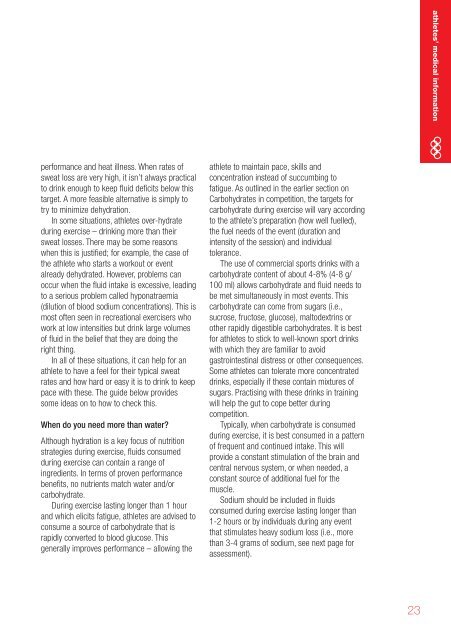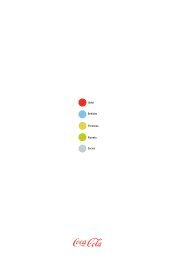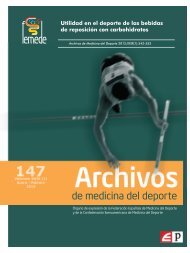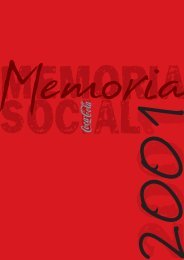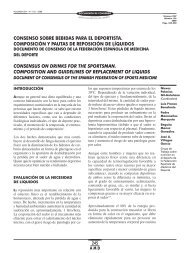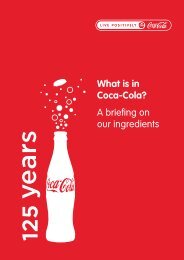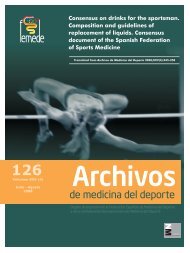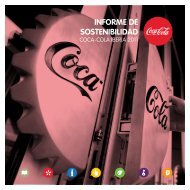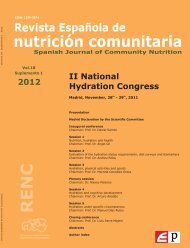Nutrition for Athletes - Coca-Cola
Nutrition for Athletes - Coca-Cola
Nutrition for Athletes - Coca-Cola
You also want an ePaper? Increase the reach of your titles
YUMPU automatically turns print PDFs into web optimized ePapers that Google loves.
athletes’ medical in<strong>for</strong>mation<br />
per<strong>for</strong>mance and heat illness. When rates of<br />
sweat loss are very high, it isn’t always practical<br />
to drink enough to keep fluid deficits below this<br />
target. A more feasible alternative is simply to<br />
try to minimize dehydration.<br />
In some situations, athletes over-hydrate<br />
during exercise – drinking more than their<br />
sweat losses. There may be some reasons<br />
when this is justified; <strong>for</strong> example, the case of<br />
the athlete who starts a workout or event<br />
already dehydrated. However, problems can<br />
occur when the fluid intake is excessive, leading<br />
to a serious problem called hyponatraemia<br />
(dilution of blood sodium concentrations). This is<br />
most often seen in recreational exercisers who<br />
work at low intensities but drink large volumes<br />
of fluid in the belief that they are doing the<br />
right thing.<br />
In all of these situations, it can help <strong>for</strong> an<br />
athlete to have a feel <strong>for</strong> their typical sweat<br />
rates and how hard or easy it is to drink to keep<br />
pace with these. The guide below provides<br />
some ideas on to how to check this.<br />
When do you need more than water<br />
Although hydration is a key focus of nutrition<br />
strategies during exercise, fluids consumed<br />
during exercise can contain a range of<br />
ingredients. In terms of proven per<strong>for</strong>mance<br />
benefits, no nutrients match water and/or<br />
carbohydrate.<br />
During exercise lasting longer than 1 hour<br />
and which elicits fatigue, athletes are advised to<br />
consume a source of carbohydrate that is<br />
rapidly converted to blood glucose. This<br />
generally improves per<strong>for</strong>mance – allowing the<br />
athlete to maintain pace, skills and<br />
concentration instead of succumbing to<br />
fatigue. As outlined in the earlier section on<br />
Carbohydrates in competition, the targets <strong>for</strong><br />
carbohydrate during exercise will vary according<br />
to the athlete’s preparation (how well fuelled),<br />
the fuel needs of the event (duration and<br />
intensity of the session) and individual<br />
tolerance.<br />
The use of commercial sports drinks with a<br />
carbohydrate content of about 4-8% (4-8 g/<br />
100 ml) allows carbohydrate and fluid needs to<br />
be met simultaneously in most events. This<br />
carbohydrate can come from sugars (i.e.,<br />
sucrose, fructose, glucose), maltodextrins or<br />
other rapidly digestible carbohydrates. It is best<br />
<strong>for</strong> athletes to stick to well-known sport drinks<br />
with which they are familiar to avoid<br />
gastrointestinal distress or other consequences.<br />
Some athletes can tolerate more concentrated<br />
drinks, especially if these contain mixtures of<br />
sugars. Practising with these drinks in training<br />
will help the gut to cope better during<br />
competition.<br />
Typically, when carbohydrate is consumed<br />
during exercise, it is best consumed in a pattern<br />
of frequent and continued intake. This will<br />
provide a constant stimulation of the brain and<br />
central nervous system, or when needed, a<br />
constant source of additional fuel <strong>for</strong> the<br />
muscle.<br />
Sodium should be included in fluids<br />
consumed during exercise lasting longer than<br />
1-2 hours or by individuals during any event<br />
that stimulates heavy sodium loss (i.e., more<br />
than 3-4 grams of sodium, see next page <strong>for</strong><br />
assessment).<br />
23


